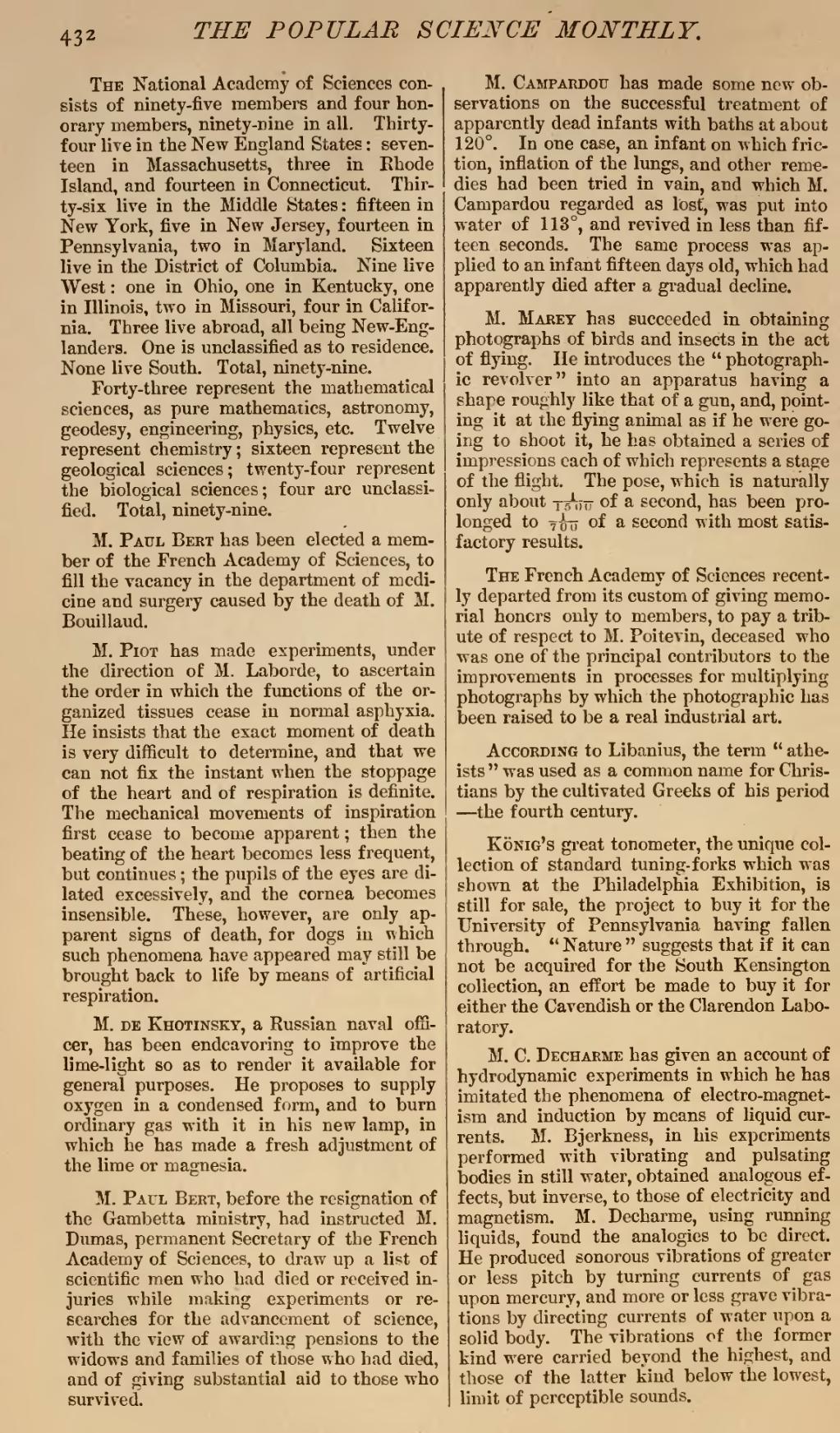The National Academy of Sciences consists of ninety-five members and four honorary members, ninety-nine in all. Thirty-four live in the New England States: seventeen in Massachusetts, three in Rhode Island, and fourteen in Connecticut. Thirty-six live in the Middle States: fifteen in New York, five in New Jersey, fourteen in Pennsylvania, two in Maryland. Sixteen live in the District of Columbia. Nine live West: one in Ohio, one in Kentucky, one in Illinois, two in Missouri, four in California. Three live abroad, all being New-Englanders. One is unclassified as to residence. None live South. Total, ninety-nine.
Forty-three represent the mathematical sciences, as pure mathematics, astronomy, geodesy, engineering, physics, etc. Twelve represent chemistry; sixteen represent the geological sciences; twenty-four represent the biological sciences; four are unclassified. Total, ninety-nine.
M. Paul Bert has been elected a member of the French Academy of Sciences, to fill the vacancy in the department of medicine and surgery caused by the death of M. Bouillaud.
M. Piot has made experiments, under the direction of M. Laborde, to ascertain the order in which the functions of the organized tissues cease in normal asphyxia. He insists that the exact moment of death is very difficult to determine, and that we can not fix the instant when the stoppage of the heart and of respiration is definite. The mechanical movements of inspiration first cease to become apparent; then the beating of the heart becomes less frequent, but continues; the pupils of the eyes are dilated excessively, and the cornea becomes insensible. These, however, are only apparent signs of death, for dogs in which such phenomena have appeared may still be brought back to life by means of artificial respiration.
M. de Khotinsky, a Russian naval officer, has been endeavoring to improve the lime-light so as to render it available for general purposes. He proposes to supply oxygen in a condensed form, and to burn ordinary gas with it in his new lamp, in which he has made a fresh adjustment of the lime or magnesia.
M. Paul Bert, before the resignation of the Gambetta ministry, had instructed M. Dumas, permanent Secretary of the French Academy of Sciences, to draw up a list of scientific men who had died or received injuries while making experiments or researches for the advancement of science, with the view of awarding pensions to the widows and families of those who had died, and of giving substantial aid to those who survived.
M. Campardou has made some new observations on the successful treatment of apparently dead infants with baths at about 120°. In one case, an infant on which friction, inflation of the lungs, and other remedies had been tried in vain, and which M. Campardou regarded as lost, was put into water of 113°, and revived in less than fifteen seconds. The same process was applied to an infant fifteen days old, which had apparently died after a gradual decline.
M. Marey has succeeded in obtaining photographs of birds and insects in the act of flying. He introduces the "photographic revolver" into an apparatus having a shape roughly like that of a gun, and, pointing it at the flying animal as if he were going to shoot it, he has obtained a series of impressions each of which represents a stage of the flight. The pose, which is naturally only about 11500 of a second, has been prolonged to 1700 of a second with most satisfactory results.
The French Academy of Sciences recently departed from its custom of giving memorial honors only to members, to pay a tribute of respect to M. Poitevin, deceased who was one of the principal contributors to the improvements in processes for multiplying photographs by which the photographic has been raised to be a real industrial art.
According to Libanius, the term "atheists" was used as a common name for Christians by the cultivated Greeks of his period—the fourth century.
König's great tonometer, the unique collection of standard tuning-forks which was shown at the Philadelphia Exhibition, is still for sale, the project to buy it for the University of Pennsylvania having fallen through. "Nature" suggests that if it can not be acquired for the South Kensington collection, an effort be made to buy it for either the Cavendish or the Clarendon Laboratory.
M. C. Decharme has given an account of hydrodynamic experiments in which he has imitated the phenomena of electro-magnetism and induction by means of liquid currents. M. Bjerkness, in his experiments performed with vibrating and pulsating bodies in still water, obtained analogous effects, but inverse, to those of electricity and magnetism. M. Decharme, using running liquids, found the analogies to be direct. He produced sonorous vibrations of greater or less pitch by turning currents of gas upon mercury, and more or less grave vibrations by directing currents of water upon a solid body. The vibrations of the former kind were carried beyond the highest, and those of the latter kind below the lowest, limit of perceptible sounds.
